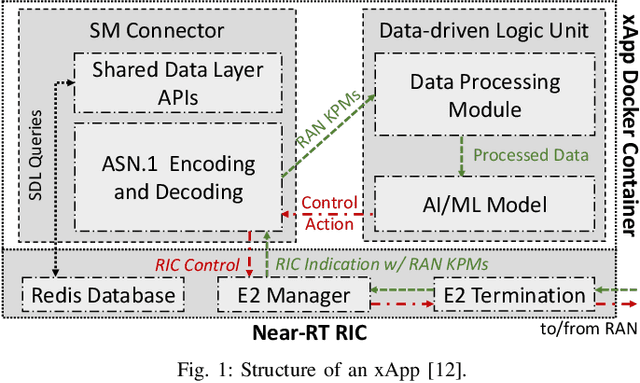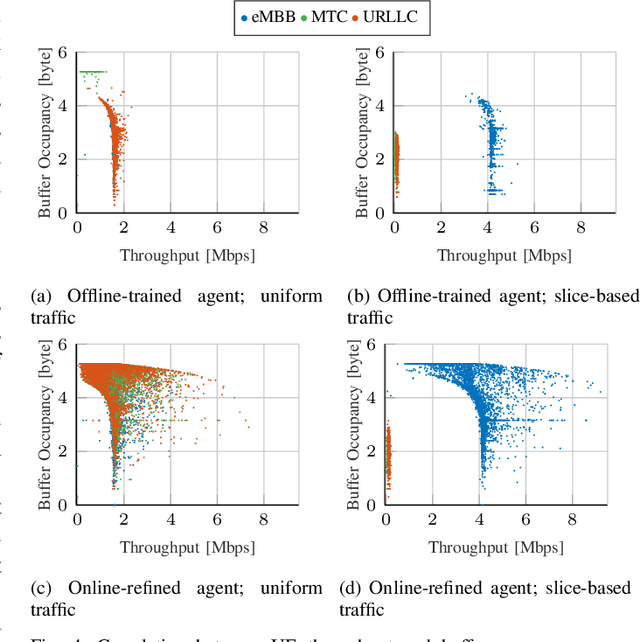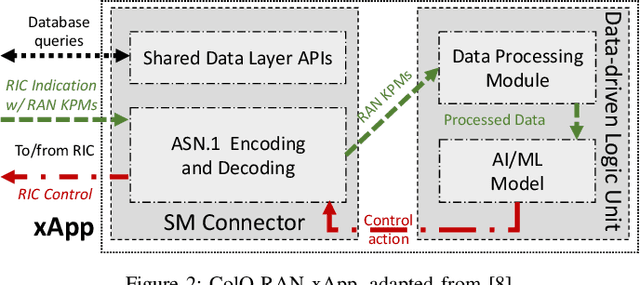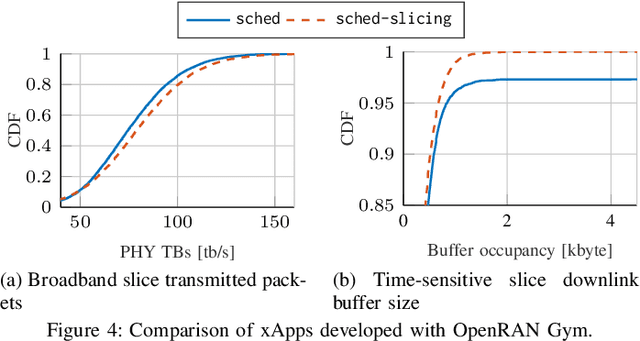Leonardo Bonati
Driving Innovation in 6G Wireless Technologies: The OpenAirInterface Approach
Dec 17, 2024


Abstract:The development of 6G wireless technologies is rapidly advancing, with the 3rd Generation Partnership Project (3GPP) entering the pre-standardization phase and aiming to deliver the first specifications by 2028. This paper explores the OpenAirInterface (OAI) project, an open-source initiative that plays a crucial role in the evolution of 5G and the future 6G networks. OAI provides a comprehensive implementation of 3GPP and O-RAN compliant networks, including Radio Access Network (RAN), Core Network (CN), and software-defined User Equipment (UE) components. The paper details the history and evolution of OAI, its licensing model, and the various projects under its umbrella, such as RAN, the CN, as well as the Operations, Administration and Maintenance (OAM) projects. It also highlights the development methodology, Continuous Integration/Continuous Delivery (CI/CD) processes, and end-to-end systems powered by OAI. Furthermore, the paper discusses the potential of OAI for 6G research, focusing on spectrum, reflective intelligent surfaces, and Artificial Intelligence (AI)/Machine Learning (ML) integration. The open-source approach of OAI is emphasized as essential for tackling the challenges of 6G, fostering community collaboration, and driving innovation in next-generation wireless technologies.
TIMESAFE: Timing Interruption Monitoring and Security Assessment for Fronthaul Environments
Dec 17, 2024



Abstract:5G and beyond cellular systems embrace the disaggregation of Radio Access Network (RAN) components, exemplified by the evolution of the fronthual (FH) connection between cellular baseband and radio unit equipment. Crucially, synchronization over the FH is pivotal for reliable 5G services. In recent years, there has been a push to move these links to an Ethernet-based packet network topology, leveraging existing standards and ongoing research for Time-Sensitive Networking (TSN). However, TSN standards, such as Precision Time Protocol (PTP), focus on performance with little to no concern for security. This increases the exposure of the open FH to security risks. Attacks targeting synchronization mechanisms pose significant threats, potentially disrupting 5G networks and impairing connectivity. In this paper, we demonstrate the impact of successful spoofing and replay attacks against PTP synchronization. We show how a spoofing attack is able to cause a production-ready O-RAN and 5G-compliant private cellular base station to catastrophically fail within 2 seconds of the attack, necessitating manual intervention to restore full network operations. To counter this, we design a Machine Learning (ML)-based monitoring solution capable of detecting various malicious attacks with over 97.5% accuracy.
Listen-While-Talking: Toward dApp-based Real-Time Spectrum Sharing in O-RAN
Jul 06, 2024Abstract:This demo paper presents a dApp-based real-time spectrum sharing scenario where a 5th generation (5G) base station implementing the NR stack adapts its transmission and reception strategies based on the incumbent priority users in the Citizen Broadband Radio Service (CBRS) band. The dApp is responsible for obtaining relevant measurements from the Next Generation Node Base (gNB), running the spectrum sensing inference, and configuring the gNB with a control action upon detecting the primary incumbent user transmissions. This approach is built on dApps, which extend the O-RAN framework to the real-time and user plane domains. Thus, it avoids the need of dedicated Spectrum Access Systems (SASs) in the CBRS band. The demonstration setup is based on the open-source 5G OpenAirInterface (OAI) framework, where we have implemented a dApp interfaced with a gNB and communicating with a Commercial Off-the-Shelf (COTS) User Equipment (UE) in an over-the-air wireless environment. When an incumbent user has active transmission, the dApp will detect and inform the primary user presence to the gNB. The dApps will also enforce a control policy that adapts the scheduling and transmission policy of the Radio Access Network (RAN). This demo provides valuable insights into the potential of using dApp-based spectrum sensing with O-RAN architecture in next generation cellular networks.
Demo: Intelligent Radar Detection in CBRS Band in the Colosseum Wireless Network Emulator
Sep 16, 2023



Abstract:The ever-growing number of wireless communication devices and technologies demands spectrum-sharing techniques. Effective coexistence management is crucial to avoid harmful interference, especially with critical systems like nautical and aerial radars in which incumbent radios operate mission-critical communication links. In this demo, we showcase a framework that leverages Colosseum, the world's largest wireless network emulator with hardware-in-the-loop, as a playground to study commercial radar waveforms coexisting with a cellular network in CBRS band in complex environments. We create an ad-hoc high-fidelity spectrum-sharing scenario for this purpose. We deploy a cellular network to collect IQ samples with the aim of training an ML agent that runs at the base station. The agent has the goal of detecting incumbent radar transmissions and vacating the cellular bandwidth to avoid interfering with the radar operations. Our experiment results show an average detection accuracy of 88%, with an average detection time of 137 ms.
A Comparative Analysis of Deep Reinforcement Learning-based xApps in O-RAN
Sep 11, 2023



Abstract:The highly heterogeneous ecosystem of Next Generation (NextG) wireless communication systems calls for novel networking paradigms where functionalities and operations can be dynamically and optimally reconfigured in real time to adapt to changing traffic conditions and satisfy stringent and diverse Quality of Service (QoS) demands. Open Radio Access Network (RAN) technologies, and specifically those being standardized by the O-RAN Alliance, make it possible to integrate network intelligence into the once monolithic RAN via intelligent applications, namely, xApps and rApps. These applications enable flexible control of the network resources and functionalities, network management, and orchestration through data-driven control loops. Despite recent work demonstrating the effectiveness of Deep Reinforcement Learning (DRL) in controlling O-RAN systems, how to design these solutions in a way that does not create conflicts and unfair resource allocation policies is still an open challenge. In this paper, we perform a comparative analysis where we dissect the impact of different DRL-based xApp designs on network performance. Specifically, we benchmark 12 different xApps that embed DRL agents trained using different reward functions, with different action spaces and with the ability to hierarchically control different network parameters. We prototype and evaluate these xApps on Colosseum, the world's largest O-RAN-compliant wireless network emulator with hardware-in-the-loop. We share the lessons learned and discuss our experimental results, which demonstrate how certain design choices deliver the highest performance while others might result in a competitive behavior between different classes of traffic with similar objectives.
Twinning Commercial Radio Waveforms in the Colosseum Wireless Network Emulator
Aug 18, 2023



Abstract:Because of the ever-growing amount of wireless consumers, spectrum-sharing techniques have been increasingly common in the wireless ecosystem, with the main goal of avoiding harmful interference to coexisting communication systems. This is even more important when considering systems, such as nautical and aerial fleet radars, in which incumbent radios operate mission-critical communication links. To study, develop, and validate these solutions, adequate platforms, such as the Colosseum wireless network emulator, are key as they enable experimentation with spectrum-sharing heterogeneous radio technologies in controlled environments. In this work, we demonstrate how Colosseum can be used to twin commercial radio waveforms to evaluate the coexistence of such technologies in complex wireless propagation environments. To this aim, we create a high-fidelity spectrum-sharing scenario on Colosseum to evaluate the impact of twinned commercial radar waveforms on a cellular network operating in the CBRS band. Then, we leverage IQ samples collected on the testbed to train a machine learning agent that runs at the base station to detect the presence of incumbent radar transmissions and vacate the bandwidth to avoid causing them harmful interference. Our results show an average detection accuracy of 88%, with accuracy above 90% in SNR regimes above 0 dB and SINR regimes above -20 dB, and with an average detection time of 137 ms.
Implementing and Evaluating Security in O-RAN: Interfaces, Intelligence, and Platforms
Apr 21, 2023



Abstract:The Open Radio Access Network (RAN) is a networking paradigm that builds on top of cloud-based, multi-vendor, open and intelligent architectures to shape the next generation of cellular networks for 5G and beyond. While this new paradigm comes with many advantages in terms of observatibility and reconfigurability of the network, it inevitably expands the threat surface of cellular systems and can potentially expose its components to several cyber attacks, thus making securing O-RAN networks a necessity. In this paper, we explore the security aspects of O-RAN systems by focusing on the specifications and architectures proposed by the O-RAN Alliance. We address the problem of securing O-RAN systems with an holistic perspective, including considerations on the open interfaces used to interconnect the different O-RAN components, on the overall platform, and on the intelligence used to monitor and control the network. For each focus area we identify threats, discuss relevant solutions to address these issues, and demonstrate experimentally how such solutions can effectively defend O-RAN systems against selected cyber attacks. This article is the first work in approaching the security aspect of O-RAN holistically and with experimental evidence obtained on a state-of-the-art programmable O-RAN platform, thus providing unique guideline for researchers in the field.
Colosseum as a Digital Twin: Bridging Real-World Experimentation and Wireless Network Emulation
Apr 13, 2023



Abstract:Wireless network emulators are being increasingly used for developing and evaluating new solutions for Next Generation (NextG) wireless networks. However, the reliability of the solutions tested on emulation platforms heavily depends on the precision of the emulation process, model design, and parameter settings. To address, obviate or minimize the impact of errors of emulation models, in this work we apply the concept of Digital Twin (DT) to large-scale wireless systems. Specifically, we demonstrate the use of Colosseum, the world's largest wireless network emulator with hardware-in-the-loop, as a DT for NextG experimental wireless research at scale. As proof of concept, we leverage the Channel emulation scenario generator and Sounder Toolchain (CaST) to create the DT of a publicly-available over-the-air indoor testbed for sub-6 GHz research, namely, Arena. Then, we validate the Colosseum DT through experimental campaigns on emulated wireless environments, including scenarios concerning cellular networks and jamming of Wi-Fi nodes, on both the real and digital systems. Our experiments show that the DT is able to provide a faithful representation of the real-world setup, obtaining an average accuracy of up to 92.5% in throughput and 80% in Signal to Interference plus Noise Ratio (SINR).
Intelligent Closed-loop RAN Control with xApps in OpenRAN Gym
Aug 31, 2022



Abstract:Softwarization, programmable network control and the use of all-encompassing controllers acting at different timescales are heralded as the key drivers for the evolution to next-generation cellular networks. These technologies have fostered newly designed intelligent data-driven solutions for managing large sets of diverse cellular functionalities, basically impossible to implement in traditionally closed cellular architectures. Despite the evident interest of industry on Artificial Intelligence (AI) and Machine Learning (ML) solutions for closed-loop control of the Radio Access Network (RAN), and several research works in the field, their design is far from mainstream, and it is still a sophisticated and often overlooked operation. In this paper, we discuss how to design AI/ML solutions for the intelligent closed-loop control of the Open RAN, providing guidelines and insights based on exemplary solutions with high-performance record. We then show how to embed these solutions into xApps instantiated on the O-RAN near-real-time RAN Intelligent Controller (RIC) through OpenRAN Gym, the first publicly available toolbox for data-driven O-RAN experimentation at scale. We showcase a use case of an xApp developed with OpenRAN Gym and tested on a cellular network with 7 base stations and 42 users deployed on the Colosseum wireless network emulator. Our demonstration shows the high degree of flexibility of the OpenRAN Gym-based xApp development environment, which is independent of deployment scenarios and traffic demand.
OpenRAN Gym: AI/ML Development, Data Collection, and Testing for O-RAN on PAWR Platforms
Jul 25, 2022



Abstract:Open Radio Access Network (RAN) architectures will enable interoperability, openness and programmable data-driven control in next generation cellular networks. However, developing and testing efficient solutions that generalize across heterogeneous cellular deployments and scales, and that optimize network performance in such diverse environments is a complex task that is still largely unexplored. In this paper we present OpenRAN Gym, a unified, open, and O-RAN-compliant experimental toolbox for data collection, design, prototyping and testing of end-to-end data-driven control solutions for next generation Open RAN systems. OpenRAN Gym extends and combines into a unique solution several software frameworks for data collection of RAN statistics and RAN control, and a lightweight O-RAN near-real-time RAN Intelligent Controller (RIC) tailored to run on experimental wireless platforms. We first provide an overview of the various architectural components of OpenRAN Gym and describe how it is used to collect data and design, train and test artificial intelligence and machine learning O-RAN-compliant applications (xApps) at scale. We then describe in detail how to test the developed xApps on softwarized RANs and provide an example of two xApps developed with OpenRAN Gym that are used to control a network with 7 base stations and 42 users deployed on the Colosseum testbed. Finally, we show how solutions developed with OpenRAN Gym on Colosseum can be exported to real-world, heterogeneous wireless platforms, such as the Arena testbed and the POWDER and COSMOS platforms of the PAWR program. OpenRAN Gym and its software components are open-source and publicly-available to the research community.
 Add to Chrome
Add to Chrome Add to Firefox
Add to Firefox Add to Edge
Add to Edge